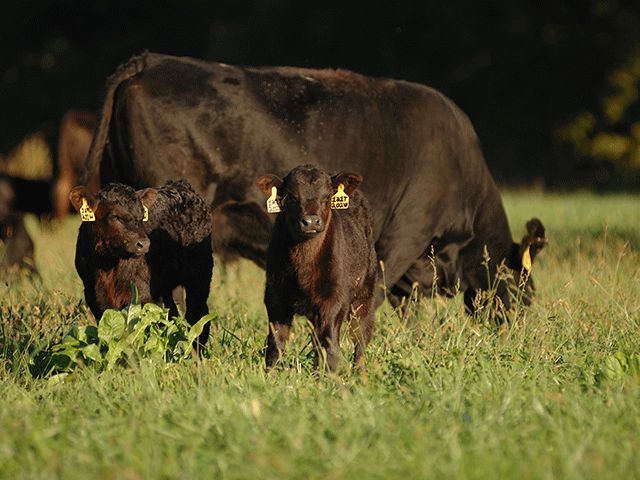Many Choices for Irrigated Pasture
Producers Needing More Pasture Can Use Irrigated Forages
OMAHA (DTN) -- Livestock producers considering irrigated pastures have several different options available to them to grow more grass. Different species, from cool- to warm-season to annuals to perennials, can be selected.
Much like dryland pastures, proper fertilization and grazing management practices can extend the grazing season. Nutrient efficiency, utilizing rotational grazing as well as not overgrazing are important practices when establishing irrigated pastures.
MANY FORAGE OPTIONS
In a presentation at the 2022 Cow-Calf College, Jerry Volesky, University of Nebraska-Lincoln (UNL) Extension range and forage specialist located at the West Central Research and Extension Center in North Platte, Nebraska, detailed some of the ways producers can utilize irrigation when grazing.
While cool-season and warm-season grasses can be considered for irrigated pastures, Volesky recommended producers utilize cool-season grasses. These grasses produce a longer grazing season compared to warm-season grasses, he said.
Producers then need to consider choosing between a single-species pasture or a mixture of different grasses and even legumes. Volesky said he would recommend a four-way mix of orchardgrass, meadow bromegrass, smooth bromegrass and creeping foxtail for his area of central Nebraska.
"A mixture of grasses can adapt to variable soils and soil moisture conditions across fields," Volesky said. "We try to encourage a mixture of species in a pasture mix."
Volesky said the inclusion of legumes such as alfalfa or clover is also a good idea. While some might be leery of a legume due to issues with animals bloating, the addition of legume plants can help a pasture stand due to its ability to fixate nitrogen in the soil.
An irrigated pasture can be seeded at a couple different points of time during the growing season, he said.
A spring seeding (March 20-April 15) could allow for a first grazing/haying by mid-July with only about a half of a productive stand. The downside with this seeding would be there is going to be some weed issues, he said.
P[L1] D[0x0] M[300x250] OOP[F] ADUNIT[] T[]
Volesky said the other time to seed would be in late summer, from Aug. 10 to Sept. 10. The pasture could be established after a wheat crop and the first grazing/haying could be ready by the next May.
Roughly 75% to 85% of the production of the stand will be seen that first spring, he said.
WATCH NUTRIENTS, IRRIGATE
Fertilizer and irrigation management are important management aspects to consider when it comes to irrigated pastures.
Volesky said studies show forages will respond up to 200 pounds per acre of nitrogen fertilizer. With fertilizer prices at record-high levels, UNL research shows 150 pounds per acre of nitrogen is an efficient level for fertilizing forages, he said.
"Seasonal split application of nutrients (50% in spring, 25% in summer and 25% in fall) can help to spoon-feed the fertilizer," he said.
Fertilizer management is tied to irrigation management, he said. North Platte, for instance, receives about 16 inches of moisture from April to October. To get to 32 to 36 inches of moisture for a full growing season of plant growth, another 16 to 20 inches will need to be applied with irrigation.
Generally, crop water use is 0.20 to 0.35 inch per day in irrigated pastures in central Nebraska. Several different factors, including soil water holding capacity, evapotranspiration and rainfall, will factor into how much irrigation water will have to be applied, he said.
Volesky said a general stocking rate for irrigated pasture is 1.25 pairs per acre for a five- to six-month grazing period. Stocking rates depend on forage types, irrigation level, quality of the stand, fertilizer management and grazing management.
"We suggest producers utilize rotational grazing with five or six paddocks," Volesky said. "There would be 15 to 25 days of a rest period during rapid (plant) growth and 25 to 40 days of rest during slow forage growth."
Volesky said an important grazing management principle would be to maintain adequate leaf or stubble height. Maintaining about 5 inches of plant height in the paddocks would assure cow-calf pairs would have enough forage for an entire grazing season at proper stocking rates, he said.
ANOTHER CHOICE: ANNUAL FORAGES
The other option for those wanting to use irrigation for forage is to plant annual forages for either grazing or cutting for a hay crop.
Again, they would be divided up into spring-seeded cool-season annuals (oats, spring barley, field peas, etc.) and fall-seeded warm-season annuals (winter wheat, rye, triticale, etc.). Spring cool-season annuals can be planed when the soils are 43-45 degrees Fahrenheit (F) from mid-March to mid-April while warm-season annuals can be seeded when the soil temperature is 60 to 70 degrees F from mid-May to August.
Producers can see good results with irrigated annual forages, he said. UNL studies show 3.5 to 4.5 tons per acre of cool-season forages can be produced, while 3 to 4.5 tons per acre of warm-season forages can be grown in irrigated situations.
Volesky said seed costs have increased in recent years as the price of nearly everything has increased. Producers should check with seed suppliers and UNL Extension to see where prices are currently at, he said.
Among the warm-season annual grasses that can be planted are sorghums. These include sudangrass and sorghum sudangrass.
Volesky said these grasses can accumulate nitrates, which can be deadly for grazing livestock. There are many reasons for the build-up of nitrates in these plants, including various weather stress, utilizing different herbicides and various plant diseases.
Producers should keep this mind when planting these forages, he said.
Russ Quinn can be reached at russ.quinn@dtn.com
(c) Copyright 2022 DTN, LLC. All rights reserved.






